
Atlas F1 Technical Writer
The opening round of the 2005 season provided the ten teams with the new challenge of having to produce an engine that lasts for two race weekends as well as tyres that can last throughout qualifying and the race without replacement. Craig Scarborough reviews the cars on their racing debut, and looks at the changes made since the teams' launches
With the race completed a picture of each team's competitiveness is still not clear, but Renault's pace cannot be denied, as with Ferrari's race pace. Surprising was the performance of Sauber and Red Bull, while McLaren's lack of race pace leaves us no closer in deciding if they will threaten to win the Championship.
Pitstops
The teams were able to counter handling imbalances with tyre pressure adjustments - in previous years the new set of tyres would be inflated to a pressure agreed between the driver and race engineer, but now the teams have specialist quick attach/detach-able airlines to inflate/deflate the tyre to the new pressure.
Reliability
With engines now required to last two races, the first race under the new rules provided some surprising interpretations of the rule. There were no actual engine failures over the weekend - this in itself is not a vindication of the rules, as the track and weather conditions conspired to make the race easier on engines, as well as the teams' conservative approach. For example, Friday's morning session saw only a few laps from all but the third drivers, in order to conserve engine mileage.
After the topsy-turvy first qualifying session, Ferrari and BAR decided to switch engines, as they would not be hindered by a ten-grid position penalty from what was already nearly a back row grid position, giving the teams fresh engines for the race. Then, at the end of the race, BAR called their drivers into the pits on the last lap - as the cars were already out of the points there was little to gain from finishing, and would allow fresh engines to be fitted to the next race. BAR's actions could be said to be outside the spirit of the rules, and is more an indication of the Honda engines current fragility than the strategy to be adopted by all teams in future races.
Williams and Ferrari suffered retirements as a result of a racing incident between Michael Schumacher and Nick Heidfeld. Ferrari have stated that the upcoming two races being in hot conditions would suit an engine change in between them, rather than preceding them. Williams have decided to switch Heidfeld's engine before Bahrain.
Tyres
So far the tyre war appears equal - in the race both suppliers' tyres held up well, with few reported problems. The tyres characteristics appear similar to last year, with the Bridgestones needing more time to warm up before remaining durable for long periods, whereas the Michelins seem to bed in faster.
In the wet Bridgestone's full wet tyres have the upper hand, while in the merely damp conditions Michelin's intermediates are the tyre to have. No tyres were changed in the race, so we will have to wait until the hotter conditions in Malaysia to see if the new breed of long life tyre can last the whole race in tougher conditions.
Team by Team
Ferrari
As expected Ferrari are running the F2004M interim car while the newly launched F2005 car undergoes its first tests back in Europe. As with most teams, Friday saw little running in the morning, with Schumacher's car suffered an electrical problem, keeping him off the track. The afternoon session saw more laps completed, balancing engine mileage against the need to set the car up and evaluate tyres.
Saturday saw Schumacher on his out lap as the rain started, leaving him with a frustratingly slow lap to complete, while Ruben Barrichello's later lap made the best of the Bridgestone's grip on the wet track but still saw him aquaplaning and struggling to keep the car on the road. With Schumacher already consigned to the back of the grid, the team decided to change his engine and not make him complete a Sunday qualifying lap. Barrichello did go out again, improving his aggregate grid position by one place.
As Schumacher was starting from the back of the grid and would need to get though the field the team filled the fuel tank up to the brim; this hindered his early laps but couldn't prevent him still having to stop twice, as the F2004M has a smaller tank than most 2005 cars. Both drivers made good starts, with Schumacher making some progress over the opening laps and then struggling to pass other cars with his heavy fuel load. Barrichello was able to make progress, but a problem with his brake balance meant the rear brakes received too much pedal pressure, leading to the rears locking up.
He drove like this for the balance of the race and was able to pass the Webber-Coulthard battle at the second round of pitstops for second. Meanwhile, Schumacher was just starting to pick up his pace coming into the second pit stop when he had an incident with Heidfeld on his out lap. The impact was enough to knock him off the track, but his engine kept running and after a push he was able to recover to the pits to retire with damaged suspension.
BAR
One of the teams with an aerodynamic shortfall, BAR returned to an older front wing design rather than the extreme front wing seen at the cars launch. The older wing sees less of a down sweep in the middle, and uses cranked endplates. The curious horizontal axe heads trailing from the bargeboards on the launch car, now feature a low turning vane that connects the axe head to the sidepod floor fin, which itself now carried a fence to its outer edge to increase the flick up effect on the air passing under the fin.
Going out only fifth on Saturday afternoon saw the track still wet in places but suited to Button's intermediate tyres. Sato was not so fortunate; he left the pits just as the rain started to fall mid session and, despite having intermediate tyres, he aquaplaned off in turn 15, wrecking his car. With the front and rear right-hand suspension needing to be changed, as well as the gear case and bodywork, the team also opted to replace the engine in order to provide Sato with the most revs for Sunday. Button's Sunday lap was a disappointing eleventh.
The team struggled getting heat into their tyres, and with Button stuck behind Villeneuve in the race the slower pace kept his tyre temperatures down. Sato started from the back of the grid and also laboured through the race to gain positions. The eventual eleventh and fourteenth places are not an indication of the teams potential.
Renault
While the R25 appeared outwardly unchanged from launch and testing specifications, the team did state it had some aero changes for this race. With the track rubbering in throughout Friday's sessions Giancarlo Fisichella noted that the car's balance needed working on, but it was an otherwise clean day for the team.
Fisichella's fortunes improved as, being twelfth man out of the pits to qualify, his lap came just as the track was at its driest, most rubbered and just before the rain fell. His lap on slick tyres was more than enough to secure pole position, even before the second qualifying session. Meanwhile Fernando Alonso going out fourth from last wasn't able to attack, leaving him in fourteenth position.
Fisichella was second on the time sheets for Sunday qualifying, but first on aggregate. Alonso's Sunday time was only seventh fastest, but still bumped him up to thirteenth on the grid. Overnight the team had changed the rear impact structures on both cars; there was no apparent reason for this, as the cars received no damage in qualifying.
At the race start the team didn't show their usual blinding launches, but were still able to retain their positions. Fisichella lead away and was never pressured, while Alonso had a battle through the field with a lengthy tussle with Villeneuve; at the last round of stops he was able to follow Barrichello past Coulthard-Webber and into third.
Williams
After publicly admitting aerodynamic problems Williams arrived in Melbourne with some new parts on the car. The sidepod floor fin had been revised; the launch car had a restrained smaller fin, but the race version had a longer fin, almost constituting a trip hazard for the drivers and mechanics. This fin serves to prevent flow going under the floor of the car, and any flow that does pass underneath the fin is flicked back up by its rounded outer edge. The fin itself creates no downforce, but the effect of a cleaner under floor airflow does improve efficiency.
Lastly the team played with different Gurney flaps for the rear wing, and one acutely angled full width flap was tried on Friday, all aimed at improving downforce from the wing. As the Melbourne track is relatively tight, and Williams are short on downforce, the mini wing mounted above the gearbox was in use all weekend.
Friday saw the car setting competitive times, and only a fuel sensor problem was noted as a problem. Running sixth and seventh on Saturday saw the cars on inters on a drying track; Nick Heidfeld over drove and went off the track momentarily, while Mark Webber's cleaner lap put him 3 seconds clear of his teammate. Webber's Sunday lap was quickest on the day, but the gap to Fisichella on aggregate was too great, while Heidfeld put in a good lap for sixth in the session.
Webber lost out to Coulthard at the start and failed to pass the Red Bull for the balance of the race. Heidfeld meanwhile had a better start but lost track position at the first stop, later colliding with Schumacher to retire from the race. BMW have announced they will change Heidfeld's engine; as he retired from the race he will not see a grid penalty in the next one.
McLaren
With a strong programme of winter testing behind them the team arrived in a positive mood for Melbourne. The MP4-20 had a number of small changes from its launch format, the most noticeable being the cut back engine cover beneath the shelf wing. As with Ferrari, McLaren have used the minimum side area of the engine cover, mounting a winglet on an extension of the spine of the cover, which forces the team to use a small strut to support the wing. The smaller amount of bodywork should improve the car's performance in yaw (slide), as the engine cover will not mask the flow to the rear wing.
While these secrets were uncovered, the team's gearbox remains hidden. The material used for the casing has yet to be confirmed; even photography of the car partially stripped of bodywork doesn't tell the story, as McLaren have adopted a Ferrari-like all enclosing aerodynamic fairing around the gearbox, with the wishbones and drive shafts emerging from small apertures leaving no view of the casing beneath. Many observers have claimed the casing to be carbon fibre, but are mislead by the black painted fairing.
Friday saw McLaren run their third car for the first time at a race weekend, with Pedro de la Rosa driving. This extra running allows McLaren to run more laps on a Friday, with the third car used to evaluate set up and tyres on longer runs. De la Rosa's Friday programme was interrupted by an off, caused by an incident with a Jordan, while Kimi Raikkonen's Friday was interrupted by an unusual decision to change gear ratios. These are normally decided from historical data and lap simulation before the cars are shipped for the weekend.
Saturdays session saw both McLaren drivers go out last on the wet track; Raikkonen's lap was quite clean, while Juan Pablo Montoya's was messier despite taking the gripper karting line into the opening corners, losing out to Raikkonen on the grid. It was Raikkonen's turn to have a messy lap on Sunday when a small off cost him time; the drivers switching position and jumping up one position collectively. Raikkonen's off lead the team to change the shelf wing in parc ferme; perhaps the tenuous mounting system couldn't withstand a rough ride over the grass.
Raikkonen's race start was also compromised when he made an error and stalled the engine as the grid formed. Forced to start from the pitlane, he was stuck behind Schumacher for most of the race until he passed at the pitstops and was able to make better progress. His middle stint was upset by his bargeboards coming adrift, having to be ripped off by mechanics at the second pit stop. Montoya meanwhile had an equally fraught race, with two incidents and again a broken bargeboard. Sixth and eighth were not the results the team expected given their stronger showing on Friday.
Sauber
After worrying comments from Peter Sauber about the car's pace during its first tests, the team ran the car with an older format front wing rather than one of the various wings seen in testing. One new feature on the car was the engine cover, sporting a full-length fin along its spine. This extends the engine cover beyond the regulated minimum, and helps resist yaw; the car is now three dimensionally shaped from the wind tunnel and CFD testing, simulating yaw at up to 6-degrees, far beyond what the car would realistically see on track. Perhaps the Sauber works too well at an angle to the car's direction, and the fin reigns in some of that behaviour.
At their first race on Michelins the car was particularly quick in Felipe Massa's hands, with Jacques Villeneuve limiting his running until the timed sessions on Saturday. Villeneuve went out in the middle of the Saturday session and opted for dry tyres, which were marginal as he spun on his out lap, ran wide at the last turn of his hot lap, and had a tricky in-lap too.
Despite the errors his lap was fast enough for fourth, but as Massa went out on his slicks for his lap the heavens opened and he struggled to complete his lap in the very worst of the conditions, even being passed by Schumacher who ran his timed lap after him. Massa did not complete a timed lap on Sunday, and Jacques lap was only eight fastest.
As Massa would be starting at the back of the grid he was topped up with fuel for a one-stop strategy; with Villeneuve being higher up the grid was on the more common two-stop plan. Villeneuve was over optimistic into the first turn and lost some positions, never picked up his pace, and was an obstacle to other cars both when being lapped and passed by faster recovering drivers. Massa soldiered through his two stints and at the end of the race was two places ahead of Villeneuve in tenth at the races end.
Red Bull
With the car's winter testing results being so encouraging, it's no surprise to see the RB1 appeared almost unchanged from its testing format. One oddity was the hole in the tip of the nose cone; most commonly this is an oval shape, but the RB1 used two small circular holes. These holes are used to send cooling air through to the cockpit, as the hydraulic powered steering rack generates a lot of heat, so the cars dampers and the drivers' feet need to be kept cool.
The team's pace from qualifying was realised in the race when Coulthard overtook Webber at the start and was later promoted to second as Trulli's race faded. He retained this position until the last stops, when the quicker pair of Barrichello and Alonso managed to pass him. Klien also had a solid race, following Montoya's McLaren home for seventh. Coulthard's fourth place finish proves the team do have the potential to head the midfield this year, but not yet to pressure Renault or Ferrari.
Toyota
Testing of the new aerodynamic package on the Toyota was deemed a success, but the car is still short on performance compared to its rivals. Mike Gascoyne has vowed to keep up a race by race development programme, and Melbourne's new parts included an extra winglet on the sidepod flip ups; most likely aimed directly at producing downforce, the winglet had an asymmetric shape and the outer edge was longer than the inner one, with the aim of spiralling its flow around and away from the rear wing.
Trulli's qualifying potential was maintained on Sunday as he posted the fourth quickest time, two seconds up on Schumacher's lap. Trulli retained this position through the races first stint, But the Toyota started to blister the rear tyres and his pace soon dropped off. Schumacher had problems with his seatbelt and had to make an extra pit for an adjustment. Ninth and twelfth place in a race with so few retirements is probably representative of the teams pace at this stage of the season.
Jordan
With little testing there were no obvious updates on the Jordan; the newer rear wing was chosen with a longer top edge and three vortex dampening slits towards the leading edge. The new Toyota engine gave the team problems in the form of an oil leak on Friday for Karthikeyan; with this solved the team's three cars completed their programme along with a number of incidents, spins and offs.
Saturday's qualifying session saw Narain Karthikeyan put in a committed lap after his fire and spin in the morning session, whereas Tiago Monteiro's lap saw the car understeer more, giving him problems in the first and third sectors. But with the conditions being drier than in the late part of the session the laps held up well, for ninth and thirteenth respectively. As Jordan were amongst the slowest qualifiers on Saturday their laps on Sunday couldn't hold back the gaggle of the McLarens, Alonso and Barrichello, so their grid positions suffered as a result.
Both drivers made hard work of the race, suffering several spins and altercations while being lapped. But the new Toyota-engined package was reliable and gave the team and its drivers valuable experience.
Minardi
Politics not withstanding the Minardi's did race, and on Saturday morning was rolled out with an aerodynamic package to meet the 2005 rules. The front wing is carried over from 2004, simply using shorter pylons to mount it higher, while the rear wing endplate followed the philosophy of the 2004 design. How Minardi tackled the floor is less clear - no clear views of the diffuser were possible - but it does appear to follow Jordan's interim diffuser design, using the taller 2004 tunnels blocked off to meet the regulated 125mm tunnel height.
Obviously no running was completed on Friday as the FIA had deemed the car to be in contravention of the 2005 aerodynamic rules. Saturday started with a spin for Patrick Friesacher, but both drivers' laps on the wet track at the start of qualifying were clean enough; at the end of the session the times were good enough for fifteenth and sixteenth.
Their races were similar to the equally inexperienced Jordan drivers; Christijan Albers lost second gear on the warm up lap and struggled on until first gear was also lost, forcing his retirement, while Friesacher struggled to keep the car on the road and keep out of the way of cars lapping him.
With the 2005 season seeing new rules for the design of the car, from the way it's operated to the running order for the weekend, the politics and mixed conditions over the race weekend tested just about every one of those rules. In many cases there have been some cheeky interpretation of rules designed to extend engine and tyre usage.
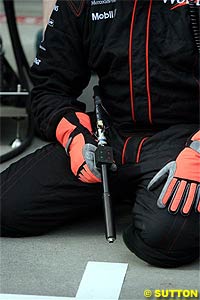 Even with tyre changing subject to time penalties, the sight of pitstops with only three mechanics was not borne out on Sunday. Mechanics were posted at each corner of the car in case tyres changes were required. As the mechanics were effectively redundant during the cars two pit stops, they instead checked the tyres for condition and wear. Wear is now measured quickly by a sequence of holes in the tyres surface, each being slightly deeper so the less holes visible then the higher the wear.
Even with tyre changing subject to time penalties, the sight of pitstops with only three mechanics was not borne out on Sunday. Mechanics were posted at each corner of the car in case tyres changes were required. As the mechanics were effectively redundant during the cars two pit stops, they instead checked the tyres for condition and wear. Wear is now measured quickly by a sequence of holes in the tyres surface, each being slightly deeper so the less holes visible then the higher the wear.
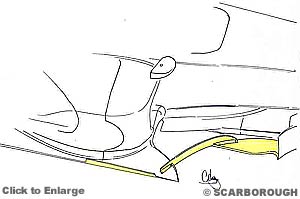 The drivers' fortunes were split on Friday when brake problems upset Takuma Sato's handling; these were soon rectified but his afternoon times did not reflect the improvement. Jenson Button had a cleaner day and ended up eighth, but struggled with poor handling during the Saturday morning session, with a change of rear end on Friday night suspected. When the old gearbox/suspension set up was reinstalled the problems went away.
The drivers' fortunes were split on Friday when brake problems upset Takuma Sato's handling; these were soon rectified but his afternoon times did not reflect the improvement. Jenson Button had a cleaner day and ended up eighth, but struggled with poor handling during the Saturday morning session, with a change of rear end on Friday night suspected. When the old gearbox/suspension set up was reinstalled the problems went away.
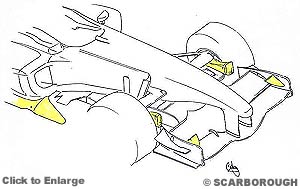 The front wing also saw a familiar Williams trick with a vortex-generating fin mounted inside the endplate. The effect of the fin and generally steeper wing angles hinder brake cooling, as the brake duct snorkels are directly behind, rather than above, the wing. Williams have discarded their more familiar duct shape and opted for BAR-like snorkels that extend around the inside of the front tyre as far the regulations allow, in order to pick up the best flow.
The front wing also saw a familiar Williams trick with a vortex-generating fin mounted inside the endplate. The effect of the fin and generally steeper wing angles hinder brake cooling, as the brake duct snorkels are directly behind, rather than above, the wing. Williams have discarded their more familiar duct shape and opted for BAR-like snorkels that extend around the inside of the front tyre as far the regulations allow, in order to pick up the best flow.
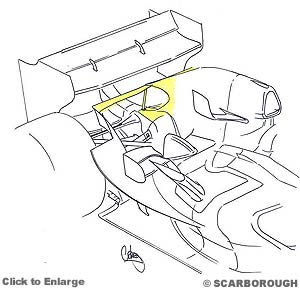 The team returned to using grooves machined into the face of the brake discs, a practice adopted frequently last year - the rear disks now sit within a dished cover. The car's radiators are also laid out differently to the MP19, forming a single panel slanted upwards in the sidepods.
The team returned to using grooves machined into the face of the brake discs, a practice adopted frequently last year - the rear disks now sit within a dished cover. The car's radiators are also laid out differently to the MP19, forming a single panel slanted upwards in the sidepods.
 With the bodywork off the car it can be seen to have a different radiator layout. Last year's car had book-folded radiators to accommodate the sidepods shape, the fold pointed backwards along the car, while the new car sees the fold pointing outwards, as with Renault's R24 set up last year. Behind the cooler sits the exhaust system; this sees the five primary exhaust pipes routed into a forward facing collector, with the secondary pipe then bent in a tight U bend to direct the flow back along the car. This places the outlet as far forward and as low as possible.
With the bodywork off the car it can be seen to have a different radiator layout. Last year's car had book-folded radiators to accommodate the sidepods shape, the fold pointed backwards along the car, while the new car sees the fold pointing outwards, as with Renault's R24 set up last year. Behind the cooler sits the exhaust system; this sees the five primary exhaust pipes routed into a forward facing collector, with the secondary pipe then bent in a tight U bend to direct the flow back along the car. This places the outlet as far forward and as low as possible.
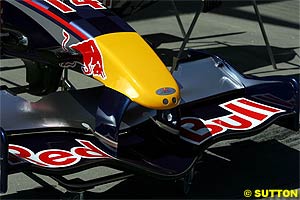 Despite being able to run a third car the team struggled with small issues; brake and throttle problems for Christian Klien and an off for Vitantonio Liuzzi. Klien went out before Trulli's front row lap and put in a solid lap for fifth; meanwhile David Coulthard lap was messier as with his intermediate tyres he suffered poor balance, grabbing brakes and oversteer. Regardless of the problems Coulthard's lap was during the better conditions, putting him a place behind Klien in sixth. The positions were reversed on Sunday when Coulthard's third fastest lap was over a second quicker than Klien's.
Despite being able to run a third car the team struggled with small issues; brake and throttle problems for Christian Klien and an off for Vitantonio Liuzzi. Klien went out before Trulli's front row lap and put in a solid lap for fifth; meanwhile David Coulthard lap was messier as with his intermediate tyres he suffered poor balance, grabbing brakes and oversteer. Regardless of the problems Coulthard's lap was during the better conditions, putting him a place behind Klien in sixth. The positions were reversed on Sunday when Coulthard's third fastest lap was over a second quicker than Klien's.
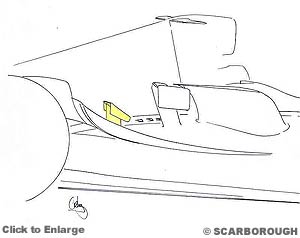 A problem free Friday saw Ricardo Zonta able to run longer tyres evaluation runs in the third car. As with Renault, Toyota's fortunes in the first qualifying session were split; Jarno Trulli put in a great lap on intermediate tyres, while Ralf Schumacher went out as the first car after Sato's red flag, with the unavoidable aquaplaning and understeer leaving him way down on the grid.
A problem free Friday saw Ricardo Zonta able to run longer tyres evaluation runs in the third car. As with Renault, Toyota's fortunes in the first qualifying session were split; Jarno Trulli put in a great lap on intermediate tyres, while Ralf Schumacher went out as the first car after Sato's red flag, with the unavoidable aquaplaning and understeer leaving him way down on the grid.
|
Contact the Author Contact the Editor |
Please Contact Us for permission to republish this or any other material from Atlas F1.
|
Volume 11, Issue 10
Articles
Paul Versus the Volcano
Chronology of a Scandal
Formula One or Formula Farce?
Ann Bradshaw: Point of View
2005 Australian GP Review
2005 Australian GP Review
Technical Review: Australia 2005
A Rainy Parade
Stats Center
SuperStats
Charts Center
Regular Columns
Season Strokes
The Weekly Grapevine
> Homepage |